Visitors to Grey Towers will come to understand the importance of the Pinchot family influence on America's conservation ethics and natural resource management policies.
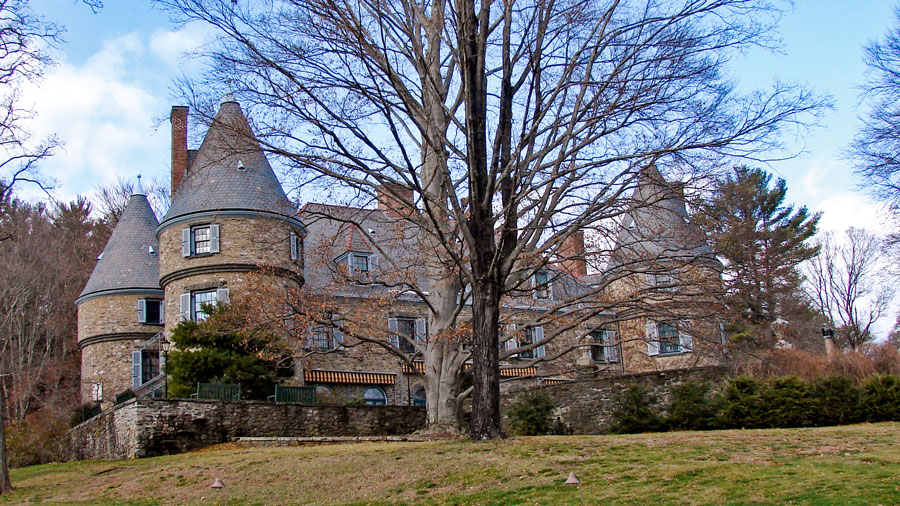
Two months before his assassination in 1963, John F. Kennedy came to Milford, Pennsylvania, to formally accept a gift for the citizens of America. The President arrived by helicopter and walked to a small wooden platform that stood among a large crowd that he addressed as "students of this community." Kennedy continued, "I don't think many Americans can point to such a distinguished record as Gifford Pinchot, whose career was best summed up in his own statement on the fortieth anniversary of the Forest Service he helped to found: 'I have been a Governor now and then. But I've been a forester all of the time and shall be until my dying day.' He was more than a forester, he was the father of American Conservation. He believed that the riches of this continent should be used by all the people to provide a more abundant life. And he believed that the waste of these resources or the exploitation by a few was a threat to our national democratic life. His career marked the beginning of a professional approach in preserving our national resources."
On top of the hill behind the platform, the Pinchot family home, reminiscent of a Medieval French castle with huge conical roofed towers rising to the sky, overlooked the ceremony, the town of Milford, and the Delaware River Valley as it had since 1886. This building, known as Grey Towers, and a 102-acre portion of the surrounding estate were dedicated that autumn day as home for the Pinchot Institute for Conservation, donated to the United States Forest Service as a public center for education and studies in environmental and natural resource policy. Three years later, Grey Towers was designated a National Historic Landmark.
Gifford Pinchot's grandfather left France with his family after Napoleon fell at Waterloo in 1819, eventually arriving at Milford in 1821 to join an already existing colony of immigrant French Huguenots. The family was not without means and quickly invested in the area's vast thickly wooded hillsides: clear-cutting timber, floating rafts of logs down the Delaware River to Trenton, walking back, and doing it again… and again. Gradually leveling the forests of Eastern Pennsylvania, the Pinchot's prospered while becoming a foundation for the Milford community and its growing commercial importance.
The subsequent Pinchot generation left Milford one by one; Gifford's father, James, to New York City where he made a fortune in wallpaper. James married Mary Jane Eno, whose family "built Broadway", bringing them into the upper echelons of American prominence. The couple resided in New York and Simsbury, Connecticut, where Gifford was born in 1865, named after their close friend, Sanford Gifford, the renowned landscape painter. Upon his retirement in 1875, James bought 3,000 acres of land overlooking the Delaware River, where he began to design and build a "summer retreat" along the lines of a European ornamental farm. In 1884, the renowned architect, Richard Morris Hunt, completed plans for the main residence, a French-style chateau, it's signature towers modeled after the Marquis de Lafayette's castle, LaGrange. Two years later, the 43-room manor was complete, constructed by Milford residents almost entirely with local hemlock, bluestone and slate.
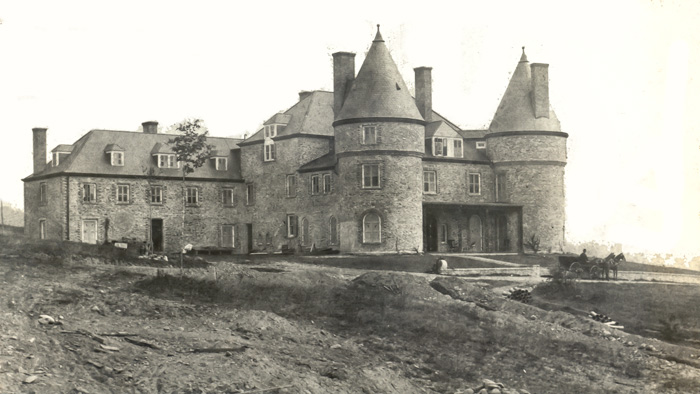
The privileges of Gifford Pinchot's youth were well spent. He grew up in New York City, spent summers in Connecticut, attended Phillips Exeter Academy in New Hampshire, and toured Europe, where he expanded his world view. He often visited his relatives in Milford, where he was always drawn to the woods. Gifford's love for the outdoors was carefully nurtured by his parents, who gave him a book written by the environmentalist George Perkins Marsh in 1860, called Man and Nature, an early argument for land stewardship as an essential factor for future human survival. James Pinchot, who had come to regret his family's destruction of Pennsylvania's forests, hoped his son would be able to enhance the Pinchot legacy through public service, a Progressive ideal that emerged in affluent late nineteenth century society. Indeed, as Gifford's twenty-first birthday celebration coincided with the opening of Grey Towers, he already shared his father's wish to repair the treeless, ravaged landscape that stretched rutted and muddy to the river banks.
After Gifford graduated Yale University in 1889, he went to England where he met Sir Dietrich Brandis, who managed British forestry projects in India, and who would later be helpful to Pinchot's efforts in the U.S.. He pursued his studies at the National Forestry Academy in France where his ideas for a professional approach to forestry began to gel. Without specialized, rigorous training, management programs in the U.S., and the tiny Division of Forestry, would never succeed beyond the local level. Pinchot, in constant communication with his parents, considered creating a forestry school at Yale, where he had adequate political and financial leverage.
In spite of his growing distaste for opulence, on his return to America, Pinchot chose to work at the Biltmore Estate in Asheville, North Carolina, which, at 125,000 acres, was the granddaddy of all America's Gilded Age domains. Conceived on the model of a European self-supporting estate, all working aspects were planned in the most minute detail. For Gifford, there were contacts and ideas, and more questions. How to make forestry profitable? Should it be driven by local, state or national authority on public or private land? At the Chicago World's Fair in 1893, Pinchot used Biltmore as an example in a pamphlet designed to illustrate the emerging concepts for forestry. He found that, although he was not yet a forester, he already excelled at telling the story.
In 1896, Gifford gained appointment to the newly formed National Forest Commission and was soon placed in charge of the country's Western forest reserves. Then in 1898, Pinchot became the chief of the Division of Forestry, part of the Department of the Interior. Meanwhile, with a $250,000 endowment from the Pinchot family, the Yale School of Forestry opened its doors in 1900, using Grey Towers for student preparatory field work (until 1926), and finding graduates work in America, rather than abroad. Pinchot also established the Society of American Foresters and a Journal of Forestry in 1900, bringing improved standing for the new profession that he had virtually created, grounded in the personal networks that he started developing as a student.

When Theodore Roosevelt became President in 1901, Pinchot's agenda leapt forward. The two men shared privileged and Progressive backgrounds, love for nature and the outdoors, and the ideals of George Perkins Marsh. Pinchot's aim was the most economically efficient use of natural resources; waste was his worst enemy. Instead of dispersing resources to private holdings, Pinchot wanted to maintain federal ownership and management of public land. In 1905, Pinchot succeeded in having the Bureau of Forestry moved from Interior to the Department of Agriculture where these resources were renamed National Forests, owned by the public, not by states. Enterprises that timbered the forests had to pay for the license to do so, under the authority of prudent management guidance and regulations set forth by the newly named U.S. Forest Service. By arguing that scientific management of forests was the most profitable, Chief Forester Pinchot disarmed those who criticized the expanded role of government in natural resources. But there was no "tree hugging" involved; Pinchot was a conservationist, not a preservationist. His Forest Service managed America's land by a simple credo: "The greatest good, for the greatest number, for the longest time". He was generally opposed to preservation simply for the sake of scenic vistas or wilderness protection; at times even conflicting with his mentor John Muir, who resisted the commercialization of nature. Pinchot's tenure lasted until 1910, when he was fired by President Taft over disagreement about who should control Alaskan coal mines. Today, the Forest Service's 34,250 employees manage 193,000,000 acres of national forest and grasslands, 14,077 recreation sites; 143,346 miles of trails; 374,883 miles of roads; and the harvesting of 1.5 billion trees each year.
After James and Mary Pinchot died, Gifford split the Milford estate in 1914 with his brother, Amos. Gifford and his new wife, Cornelia Bryce, took the main house and began spending summers there. As they both developed promising political careers, Grey Towers became their permanent residence. Cornelia ran for Congress three times, and Gifford served as Governor of Pennsylvania from 1923 to 1927, and again from 1931 to 1935. As their lives changed, so did Cornelia transform Grey Towers into a family home, a working office for the Governor, and welcome center for dignitaries from around the world. Outbuildings, known as "rooms", sprang up on the grounds. First the Bait Box, a cottage playroom built for the Pinchot's son when he was thirteen. Later used as a tea room, there is a long reflecting pool in front, wider at the near end to add artificial perspective, making the pool seem longer. When Pinchot served his first term as Governor, a large stone cottage called the Letter Box served as an office for his staff and as an archive for his papers. And visitors today can still linger around the Finger Bowl, an outdoor dining area enclosed by stone piers supporting a wisteria-covered arbor over head. Guests dined around a raised pool rimmed by a flat ledge, their food served from bowls floating on the water.
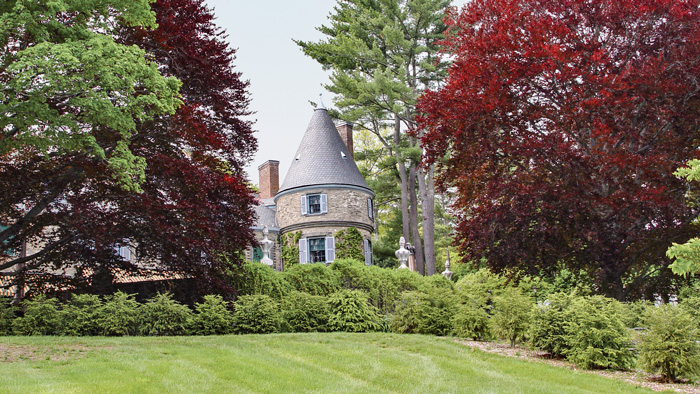
From the east terrace, New Jersey's High Point monument peaks across the way over the Delaware, but the river itself is no longer visible as it was on Gifford Pinchot's twenty-first birthday. Trees and manicured lawns and gardens fill the space down the hill towards Milford. Looking back at the house, a bust of Lafayette recalls the building's French derivation and beckons to come inside.
For all the good intentions of Grey Tower's transfer to the Forest Service in 1963, there was not a clear understanding about what could be done, and it took years to figure out what the best use for the property would be. For decades, the house was public, but not well funded, and without clear focus or direction. Most of all, the Pinchot family desired that the place be, rather than a shrine, an active center for learning and continued dialogs. In 2000, the building closed for two years to undergo major renovation. Today the first floor is a replica of the original living quarters, while the second and third floors serve as conference center facilities. Any group whose business is environmental conservation can use these meeting spaces, for free.
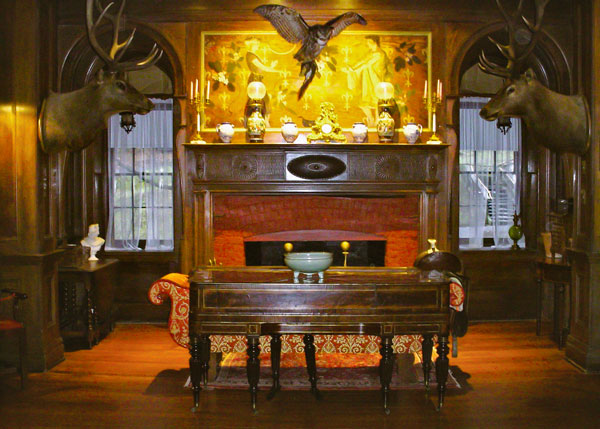
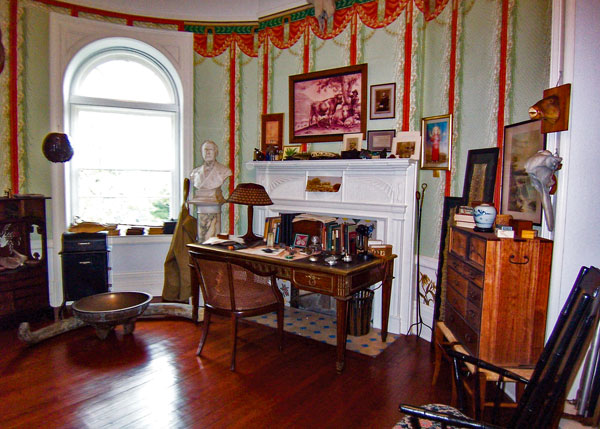
Visitors enter the building at the great hall, where James and Mary Pinchot greeted guests in the late nineteenth century. There are original artifacts in settings recreated from period photos: a parlor piano, a riding saddle tossed on the couch, and a sailor cap perched on the antler of an elk mounted over the sitting area. There are replicas of colossal Oriental rugs, original furniture carved with Bible scenes from the Italian Renaissance, and curiosities such as a courting candle. Guests could access a water closet through a door set on a custom pin hinge, flush into the ornate paneling under the stairway. Portraits of Mary and James hang across the room, framing the entrance into the adjoining chamber which is now arranged as it was by the family's next generation. In the 1920s, Gifford and Cornelia combined several smaller rooms into one spacious sitting room and library. The space, surrounded by stately shelves that hold hundreds of volumes, is filled with countless items, decorative and historic, that promise endless fascination. Off one corner of the room is Gifford Pinchot's office, restored exactly as it was until he died in 1946.
Gifford Pinchot based his conservation policies on a larger framework of political philosophy that emphasized social justice, and a will to make the common man's life better. Resource management was a method to repair human society as well as the land, and as governor he continued to champion environmental legislation. During the Depression, Pinchot embarked on a massive rural improvement program, hiring men, not machines, to pave thousands of miles of "Pinchot roads", intended to provide Pennsylvania farmers easier access to markets. Pinchot also used state funds to buy cheap forest lands from distressed lumber companies and hired workers to replant. These programs prompted Franklin Roosevelt to ask Pinchot for direction in creating the Civilian Conservation Corps. Cornelia was equally passionate in her politics, beginning with vigorous support for woman's suffrage. She endorsed birth control, women's rights and educational reform; and condemned sweat shops and child labor. And it was her influence that added the social component to Gifford's scientific approach to conservation. Gifford's brother, Amos, who became a lawyer in part to handle the family's estate and to free Gifford from that worry, went on to become a founder of the American Civil Liberties Union.
Shortly before he died, Pinchot completed his autobiography, Breaking New Ground, published posthumously in 1947. His writing applied his policies, politics and philosophies to the world, interpreting World War II as a conflict over natural resources, industrial states competing for access, Germany and Japan chasing coal. He realized that there would be no peace until environmental justice became an integral part of human life. He proposed an international organization to oversee equitable distribution of natural resources. He saw danger in the emergence of multinational corporations, whose policies would be without regard to the public issues of any country. These were radical ideas then, especially for an established Federal official and Governor; a Republican to boot. But they still draw lines familiar in political and environmental activist theater today, where conservation and social issues are inextricably interwoven. Provisions for a sustainable world depend on the "greatest good for the greatest number for the longest time"
The grounds at Grey Towers are open from sunrise to sunset year-round, where there are self-guided interpretive trails devoted to the history of the Pinchot family, forestry and the bluebirds nesting in the woods. From Memorial Day weekend through early November, guided tours of the home and gardens begin every hour on the hour from 10am - 4pm. There is a fee except for July 4 (Independence Day) and September 22 (U.S. Public Lands Day). There is also a gift shop. The Grey Towers Heritage Association website contains additional information about events at Grey Towers and about the family Pinchot. For general information call 570/296-9630
The Pinchot Institute hosts, without charge, conferences related to conservation matters, held either in the upper floors of the mansion or in the Letter Box. The Forest Service at Grey Towers offers a variety of conservation education programs for students grades 4-12. Teacher workshops and education programs are free of charge offered in partnership with other regional organizations and agencies. For additional information on conservation education programs please contact Lori McKean at the Grey Towers National Historic Site, P.O. Box 188, Milford, PA 18337. Call 570/296-9672 or email.
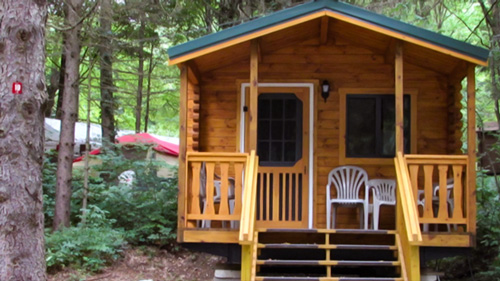
Located in Sussex County near the Kittatinny Mountains the camping resort offers park model, cabin and luxury tent rentals as well as trailer or tent campsites with water, electric and cable TV hookups on 200 scenic acres.
Peters Valley shares the experience of the American Craft Movement through interactive workshop learning through a series of workshops. A shop and gallery showcases the contemporary craft of residents and other talented artists at the Crafts Center...ceramics, glass, jewelry, wood and more in a beautiful natural setting. Open year round. Closed Thursday.
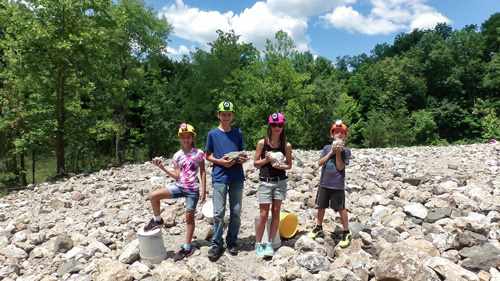
“The Fluorescent Mineral Capitol of the World" Fluorescent, local & worldwide minerals, fossils, artifacts, two-level mine replica.
Follow the tiny but mighty Wallkill River on its 88.3-mile journey north through eastern Sussex County into New York State.